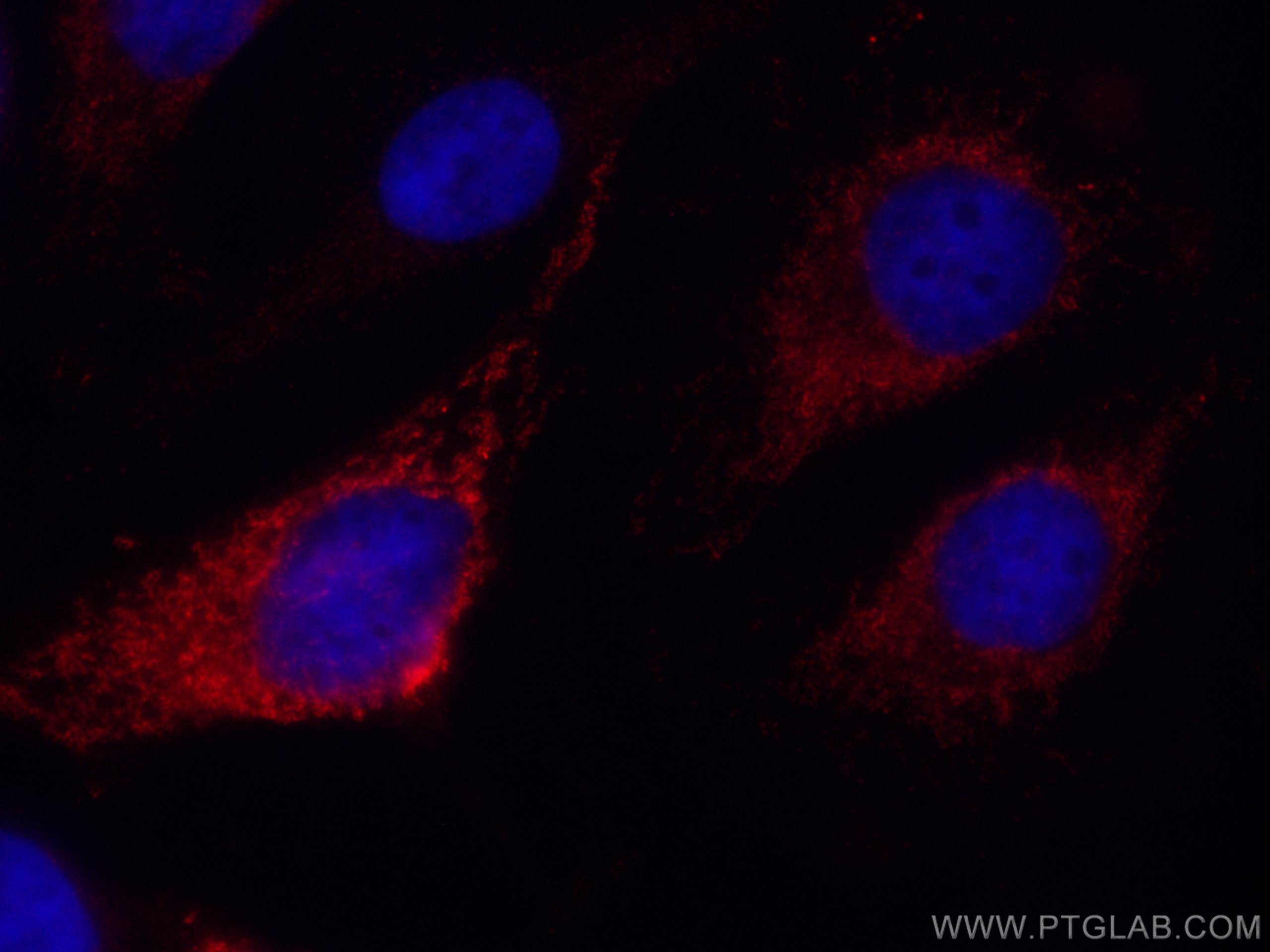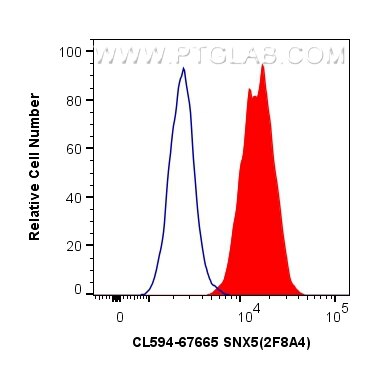SNX5 Monoklonaler Antikörper
SNX5 Monoklonal Antikörper für IF/ICC, FC (Intra)
Wirt / Isotyp
Maus / IgG2a
Getestete Reaktivität
human, Maus, Ratte
Anwendung
IF/ICC, FC (Intra)
Konjugation
CoraLite®594 Fluorescent Dye
CloneNo.
2F8A4
Kat-Nr. : CL594-67665
Synonyme
Geprüfte Anwendungen
| Erfolgreiche Detektion in IF/ICC | HeLa-Zellen |
| Erfolgreiche Detektion in FC (Intra) | HeLa-Zellen |
Empfohlene Verdünnung
| Anwendung | Verdünnung |
|---|---|
| Immunfluoreszenz (IF)/ICC | IF/ICC : 1:50-1:500 |
| Durchflusszytometrie (FC) (INTRA) | FC (INTRA) : 0.40 ug per 10^6 cells in a 100 µl suspension |
| It is recommended that this reagent should be titrated in each testing system to obtain optimal results. | |
| Sample-dependent, check data in validation data gallery | |
Produktinformation
CL594-67665 bindet in IF/ICC, FC (Intra) SNX5 und zeigt Reaktivität mit human, Maus, Ratten
| Getestete Reaktivität | human, Maus, Ratte |
| Wirt / Isotyp | Maus / IgG2a |
| Klonalität | Monoklonal |
| Typ | Antikörper |
| Immunogen | SNX5 fusion protein Ag12330 |
| Vollständiger Name | sorting nexin 5 |
| Berechnetes Molekulargewicht | 404 aa, 47 kDa |
| Beobachtetes Molekulargewicht | 47 kDa |
| GenBank-Zugangsnummer | BC093623 |
| Gene symbol | SNX5 |
| Gene ID (NCBI) | 27131 |
| Konjugation | CoraLite®594 Fluorescent Dye |
| Excitation/Emission maxima wavelengths | 588 nm / 604 nm |
| Form | Liquid |
| Reinigungsmethode | Protein-A-Reinigung |
| Lagerungspuffer | PBS with 50% glycerol, 0.05% Proclin300, 0.5% BSA |
| Lagerungsbedingungen | Bei -20°C lagern. Vor Licht schützen. Nach dem Versand ein Jahr stabil. Aliquotieren ist bei -20oC Lagerung nicht notwendig. 20ul Größen enthalten 0,1% BSA. |
Hintergrundinformationen
Sorting nexins are a diverse group of cytoplasmic and membrane-associated proteins that are classified by the presence of a phospholipid-binding motif-the PX domain (PMID:12461558). They are involved in endocytosis and protein trafficking. SNX5 (Sorting nexin-5) was originally identified as a putative FANCA-binding protein (PMID: 10600472). SNX5 has a phox homology (PX) domain in the N-terminus. It is involved in several stages of intracellular trafficking. SNX5 is a component of the mammalian retromer complex, which is involved in recycling proteins from endosomes to the trans-Golgi network or plasma membrane (PMID: 17148574; 26199408).
Protokolle
| PRODUKTSPEZIFISCHE PROTOKOLLE | |
|---|---|
| IF protocol for CL594 SNX5 antibody CL594-67665 | Protokoll herunterladen |
| FC protocol for CL594 SNX5 antibody CL594-67665 | Download protocol |
| STANDARD-PROTOKOLLE | |
|---|---|
| Klicken Sie hier, um unsere Standardprotokolle anzuzeigen |



